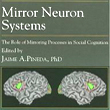Monday, 7 January 2013
Eight Problems with Mirror Neurons
 Mirror neurons are neurons with fascinating characteristics that were discovered in monkeys in the mid-1990s. Located mainly in Area F5 of the cortex, these neurons are activated not only when a monkey performs a specific action but also when that monkey simply sees another monkey perform that same action. This is surprising behaviour, to say the least, for neurons located in a motor area of the cortex.
Mirror neurons are neurons with fascinating characteristics that were discovered in monkeys in the mid-1990s. Located mainly in Area F5 of the cortex, these neurons are activated not only when a monkey performs a specific action but also when that monkey simply sees another monkey perform that same action. This is surprising behaviour, to say the least, for neurons located in a motor area of the cortex.
Since just about the same area (the premotor area) exists in the human brain, it is highly likely that humans also have mirror neurons. But the data that have been gathered on this subject remain controversial, because of constraints on experiments with human beings.
One of the first hypotheses about the possible role of mirror neurons was that they make it possible for one individual to understand another’s actions. We understand our own actions quite well, so it is logical to suppose that if the same neurons fire when we see someone else perform a similar action, the firing of these neurons tells us what this individual is doing. And this is indeed one of the most widespread interpretations of the function of mirror neurons.
But in an article published in 2009, Gregory Hickok stirred up considerable controversy by showing that this theory of “action understanding” was poorly supported by the experimental data. He even described eight distinct problems wherein the experimental data frequently contradict this theory.
Because this explanatory theory reveals such major flaws on close inspection, Hickok cautioned against its general acceptance. According to him, the reason that it has been so widely endorsed is that it is easy to understand and seems self-evident. But for this very reason, it has interfered with the investigation of other, potentially equally interesting functions for mirror neurons.
One such possible function that Hickok cites was proposed by Mahon and Caramazza (2008): that mirror neurons may provide a sensorimotor enrichment for certain abstract concepts, such as playing a saxophone or dancing a particular dance. As a result of this enrichment mechanism, someone who plays this instrument or dances this dance could more readily judge someone else’s skill by watching them do so, whereas a non-musician or non-dancer would have more trouble in making this judgment.
![]() Problems for the mirror neuron theory of action understanding
Problems for the mirror neuron theory of action understanding
![]() Eight Problems for the Mirror Neuron Theory of Action Understanding in Monkeys and Humans
Eight Problems for the Mirror Neuron Theory of Action Understanding in Monkeys and Humans
![]() Where do mirror neurons come from?
Where do mirror neurons come from?
Body Movement and the Brain | 2 comments »








[…] involved in the empathic response in humans. But this post discusses an article that questions the very existence of mirror neurons in our species, on the basis of criteria defined by the […]
[…] involved in the empathic response in humans. But this post discusses an article that questions the very existence of mirror neurons in our species, on the basis of criteria defined by the […]